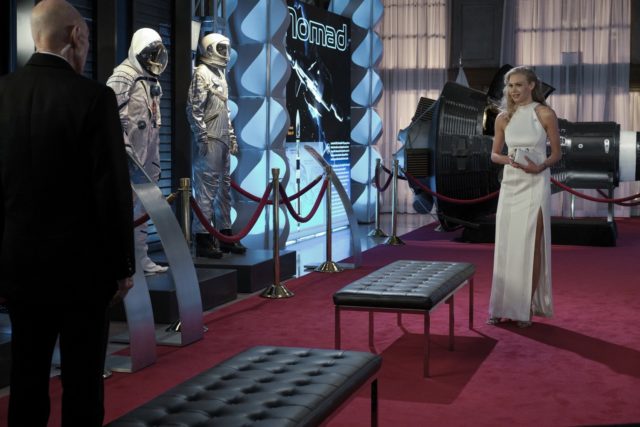I did a lot of freeze-framing on this one, trying to make out as much as I could. In addition to various models, we see:
1)a poster of an Apollo Command/Service/Lunar module assembly, above a side view of a space shuttle (which seems too small, thus out of scale)
2)A floor-to-ceiling Saturn V poster, inexplicably titled "Flight 1961-2024." Interestingly, a single angle reveals a smaller rocket (likewise sporting a spiffy black and white paint job), seemingly in scale with the Saturn V, atop which is...Elon Musk's SpaceX Crew Dragon capsule.
Per canon, TOS's 1968 Earth featured two distinct Saturn V launch facilities (by which I don't mean pads; the entire complex, Vehicle Assembly Building included). How do we know "McKinley Rocket Base" isn't Kennedy Space Center by another name? From TOS's first trip to the late 1960s:
MAN [OC]: This is the five thirty news summary. Cape Kennedy. The first manned Moon shot is scheduled for Wednesday, six am Eastern Standard Time. All three astronauts who are to make this historic
(Kirk signals it cut off)
In reality, JFK's murder was commemorated in two ways. NASA's Apollo facility became "Kennedy Space Center," and Cape Canaveral became Cape Kennedy (until 1973, when it reverted to its prior name). The Cape being the lesser of the two (not in size, but significance), it makes no sense that in TOS it would bear JFK's name, but the launch center have McKinley's.
Thus, by 1968, a nuclear bomb satellite was being lofted from what was presumably an Air Force Saturn V site named (for some unknown reason) "McKinley Rocket Base" (which I've located, by the way, with a fair-to-middling match to the map seen in "Assignment: Earth").
Personally, I've no doubt the Picard tech advisory staff knows this. They can't come out and say it literally, of course, for fear of management and/or fandom ("MY Star Trek's in MY future! NO RETCONS!")...but as usual, Picard's trip to the (now) near future has THAT time VERY different from what will come in 2 years (or indeed 20, I imagine): a piloted mission to Europa.
So what, you ask? Just this: "Flight 1961-2024" makes a sort of sense (in reality, 1961 lacked authorization of Apollo or finalization of the Saturn V design--so WTF?), IF Picard's (a.k.a. the "deep canonical") 2024 is/will be the year of the Saturn V's retirement.
1)a poster of an Apollo Command/Service/Lunar module assembly, above a side view of a space shuttle (which seems too small, thus out of scale)
2)A floor-to-ceiling Saturn V poster, inexplicably titled "Flight 1961-2024." Interestingly, a single angle reveals a smaller rocket (likewise sporting a spiffy black and white paint job), seemingly in scale with the Saturn V, atop which is...Elon Musk's SpaceX Crew Dragon capsule.
Per canon, TOS's 1968 Earth featured two distinct Saturn V launch facilities (by which I don't mean pads; the entire complex, Vehicle Assembly Building included). How do we know "McKinley Rocket Base" isn't Kennedy Space Center by another name? From TOS's first trip to the late 1960s:
MAN [OC]: This is the five thirty news summary. Cape Kennedy. The first manned Moon shot is scheduled for Wednesday, six am Eastern Standard Time. All three astronauts who are to make this historic
(Kirk signals it cut off)
In reality, JFK's murder was commemorated in two ways. NASA's Apollo facility became "Kennedy Space Center," and Cape Canaveral became Cape Kennedy (until 1973, when it reverted to its prior name). The Cape being the lesser of the two (not in size, but significance), it makes no sense that in TOS it would bear JFK's name, but the launch center have McKinley's.
Thus, by 1968, a nuclear bomb satellite was being lofted from what was presumably an Air Force Saturn V site named (for some unknown reason) "McKinley Rocket Base" (which I've located, by the way, with a fair-to-middling match to the map seen in "Assignment: Earth").
Personally, I've no doubt the Picard tech advisory staff knows this. They can't come out and say it literally, of course, for fear of management and/or fandom ("MY Star Trek's in MY future! NO RETCONS!")...but as usual, Picard's trip to the (now) near future has THAT time VERY different from what will come in 2 years (or indeed 20, I imagine): a piloted mission to Europa.
So what, you ask? Just this: "Flight 1961-2024" makes a sort of sense (in reality, 1961 lacked authorization of Apollo or finalization of the Saturn V design--so WTF?), IF Picard's (a.k.a. the "deep canonical") 2024 is/will be the year of the Saturn V's retirement.



